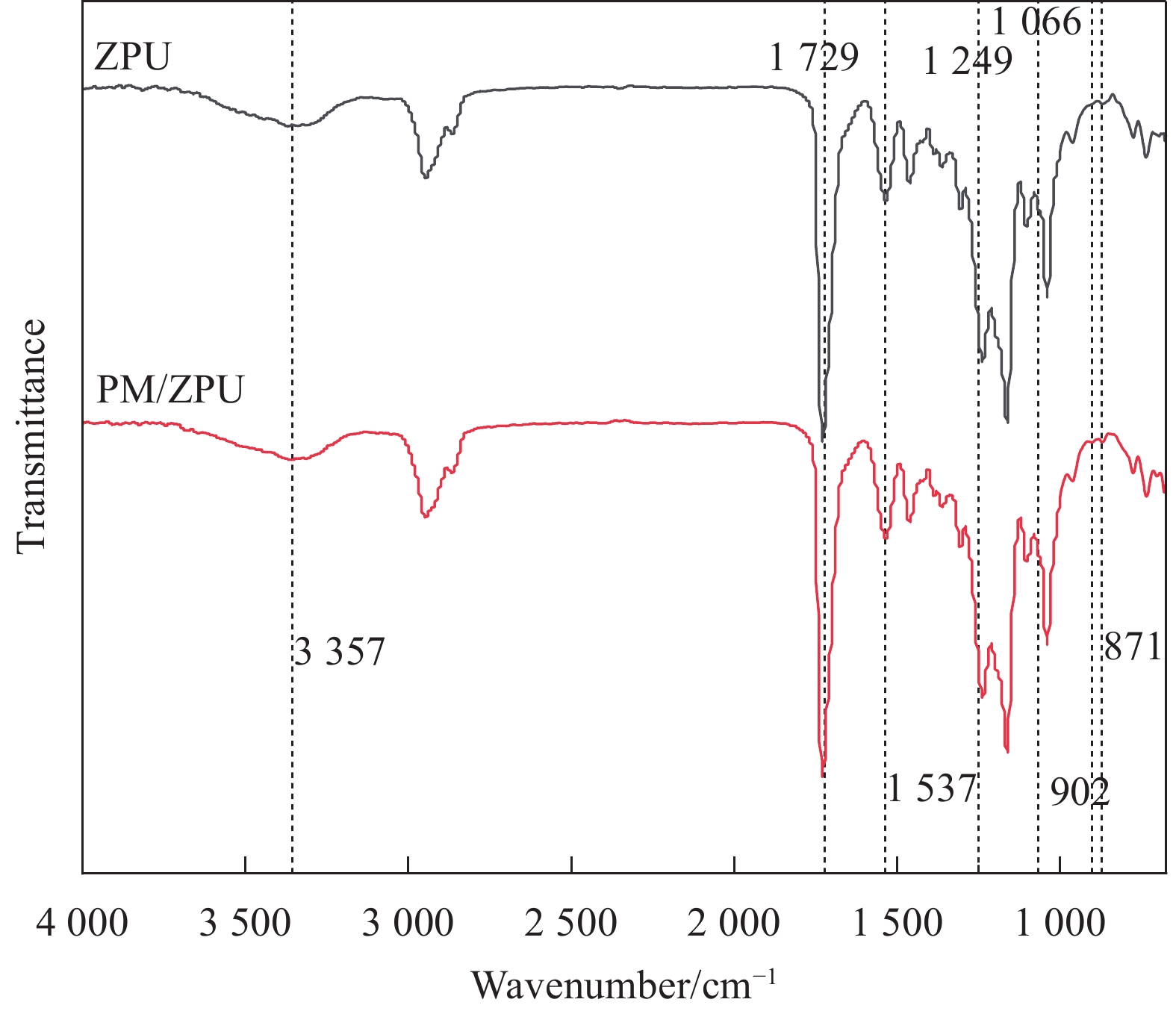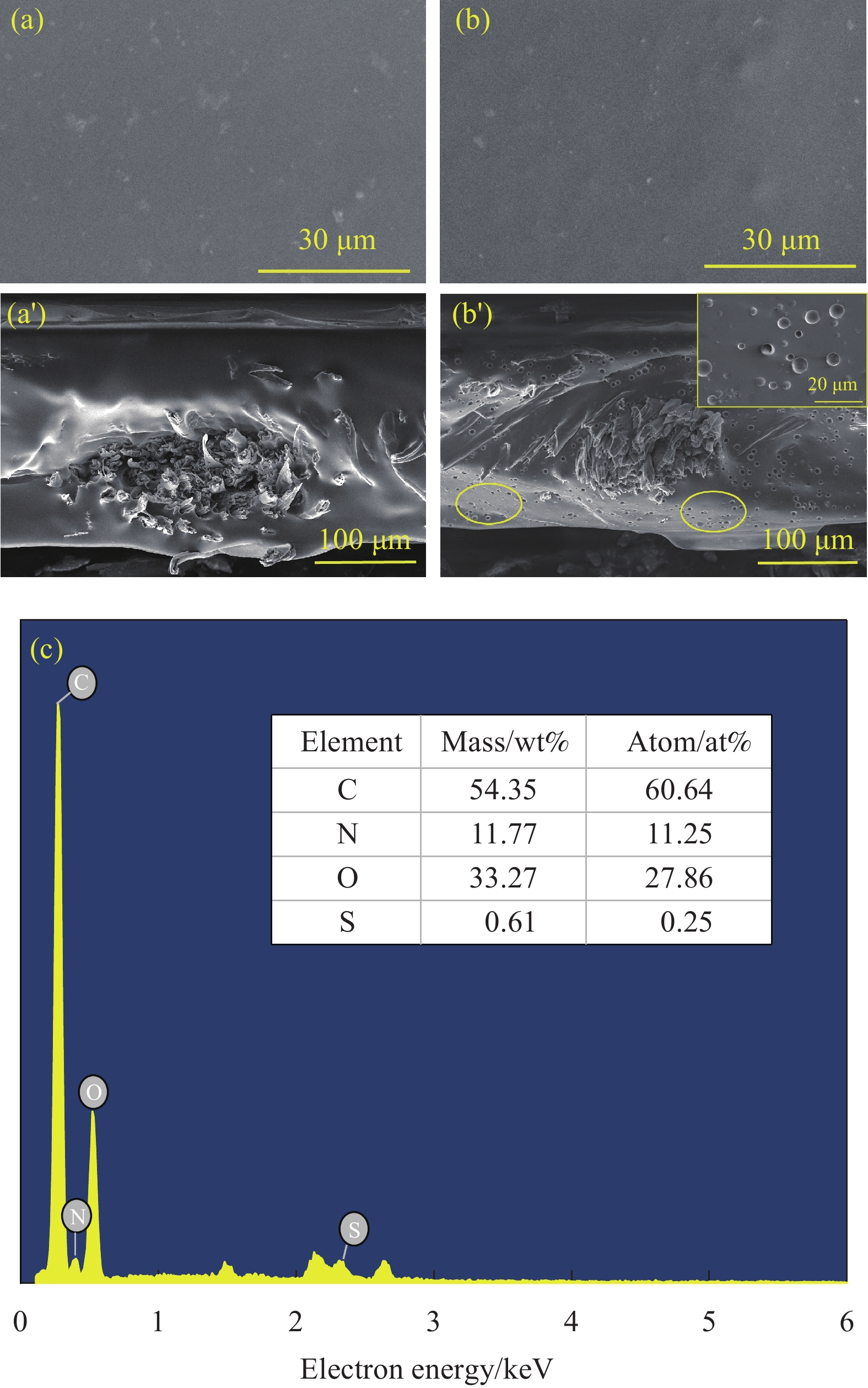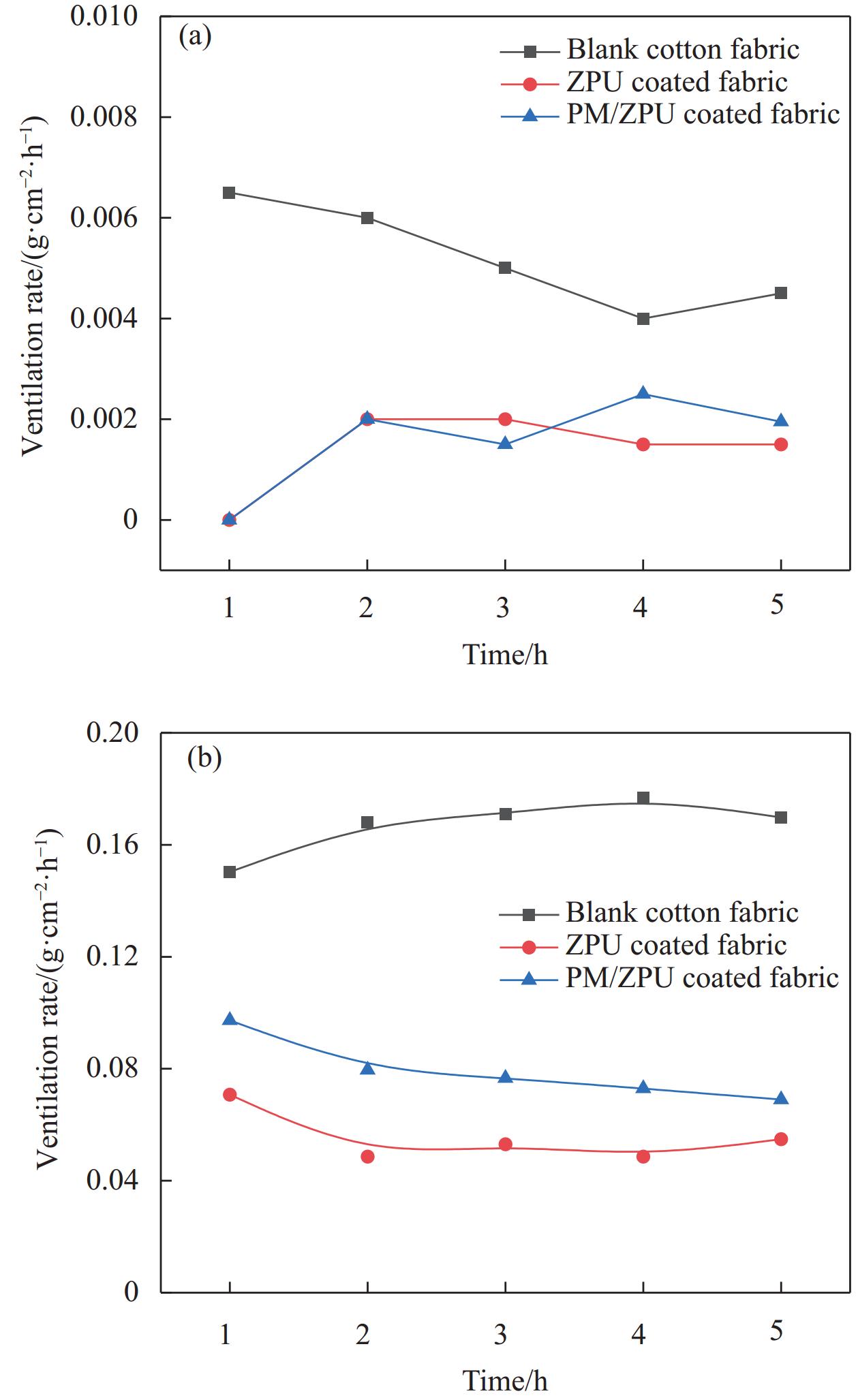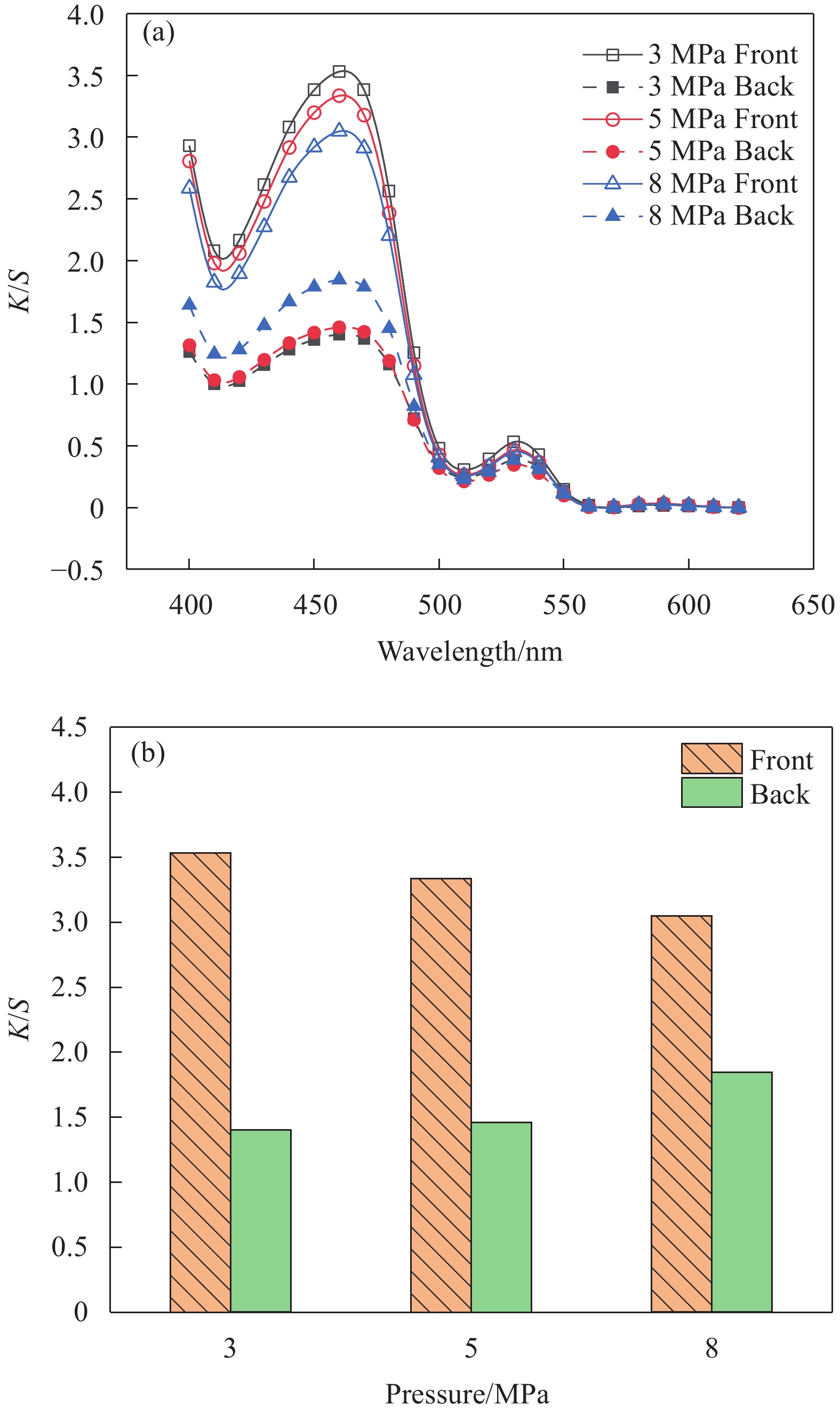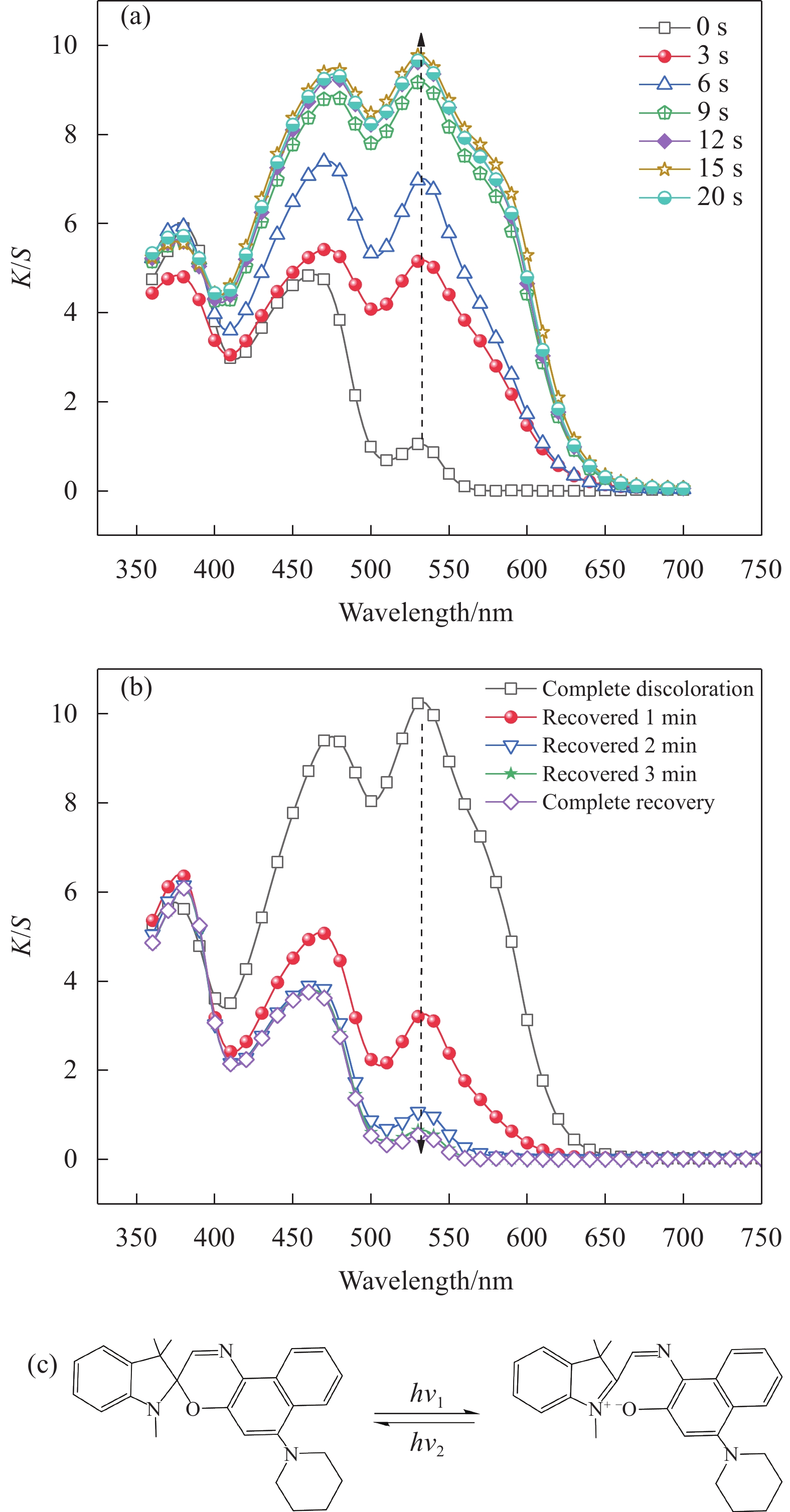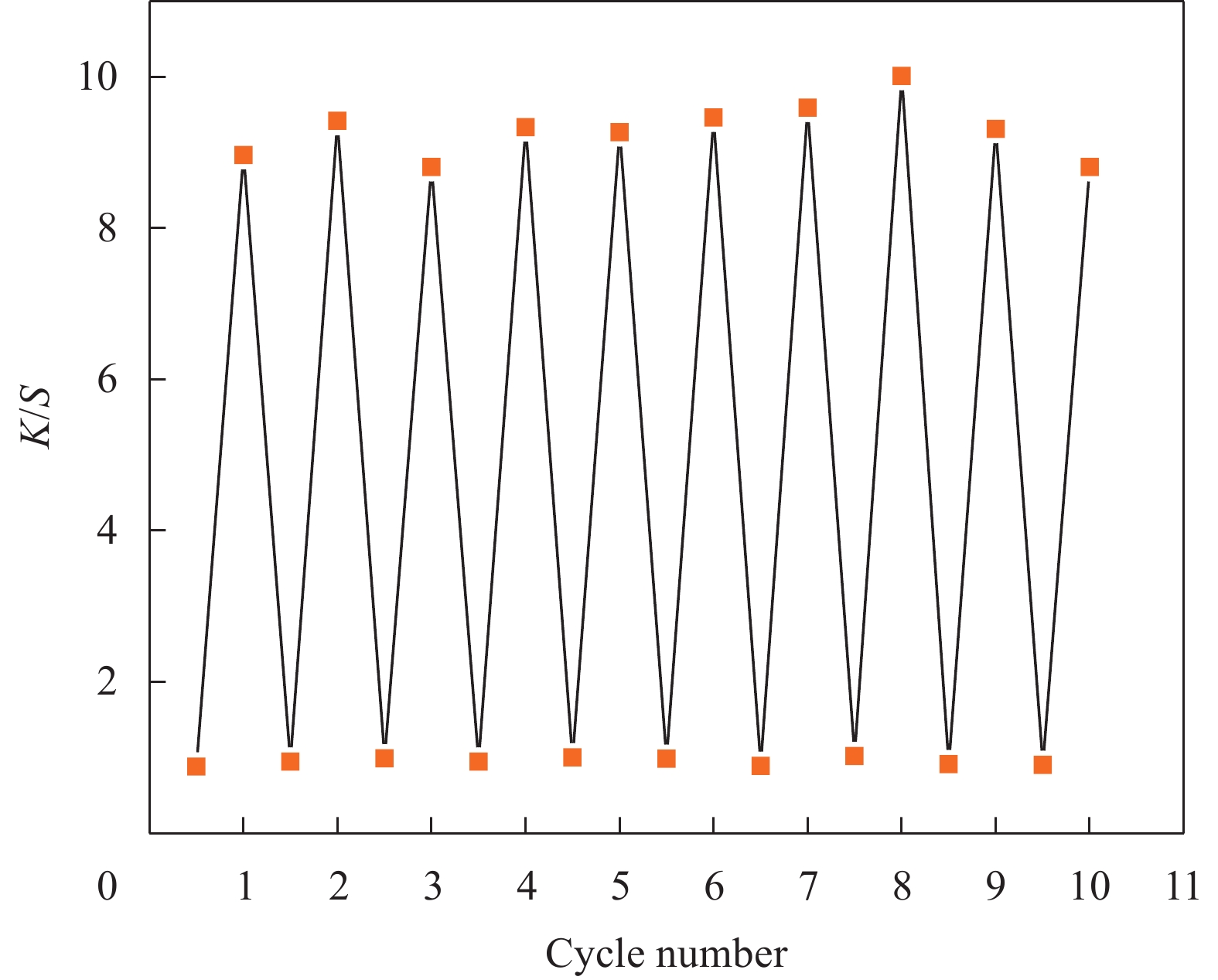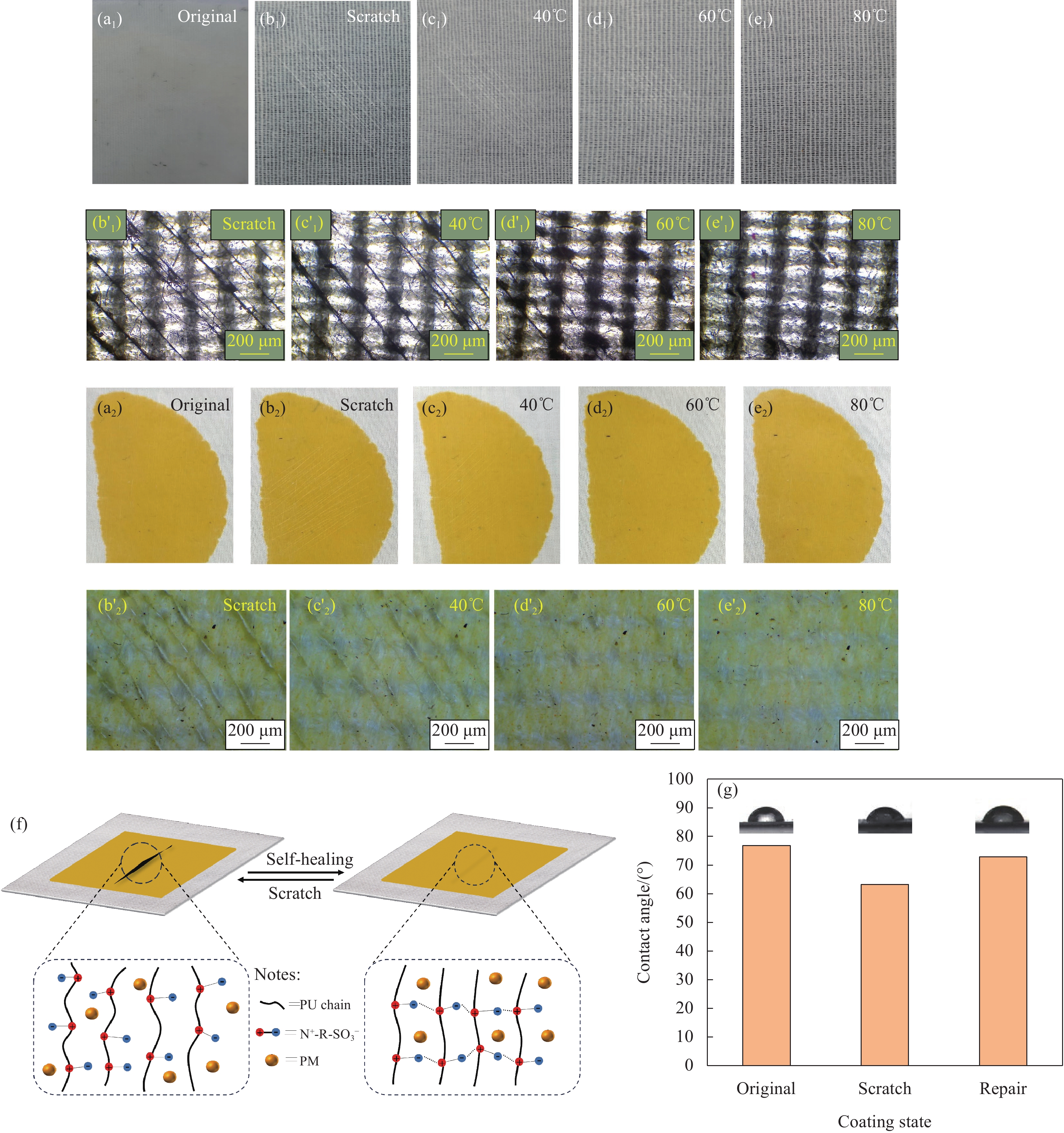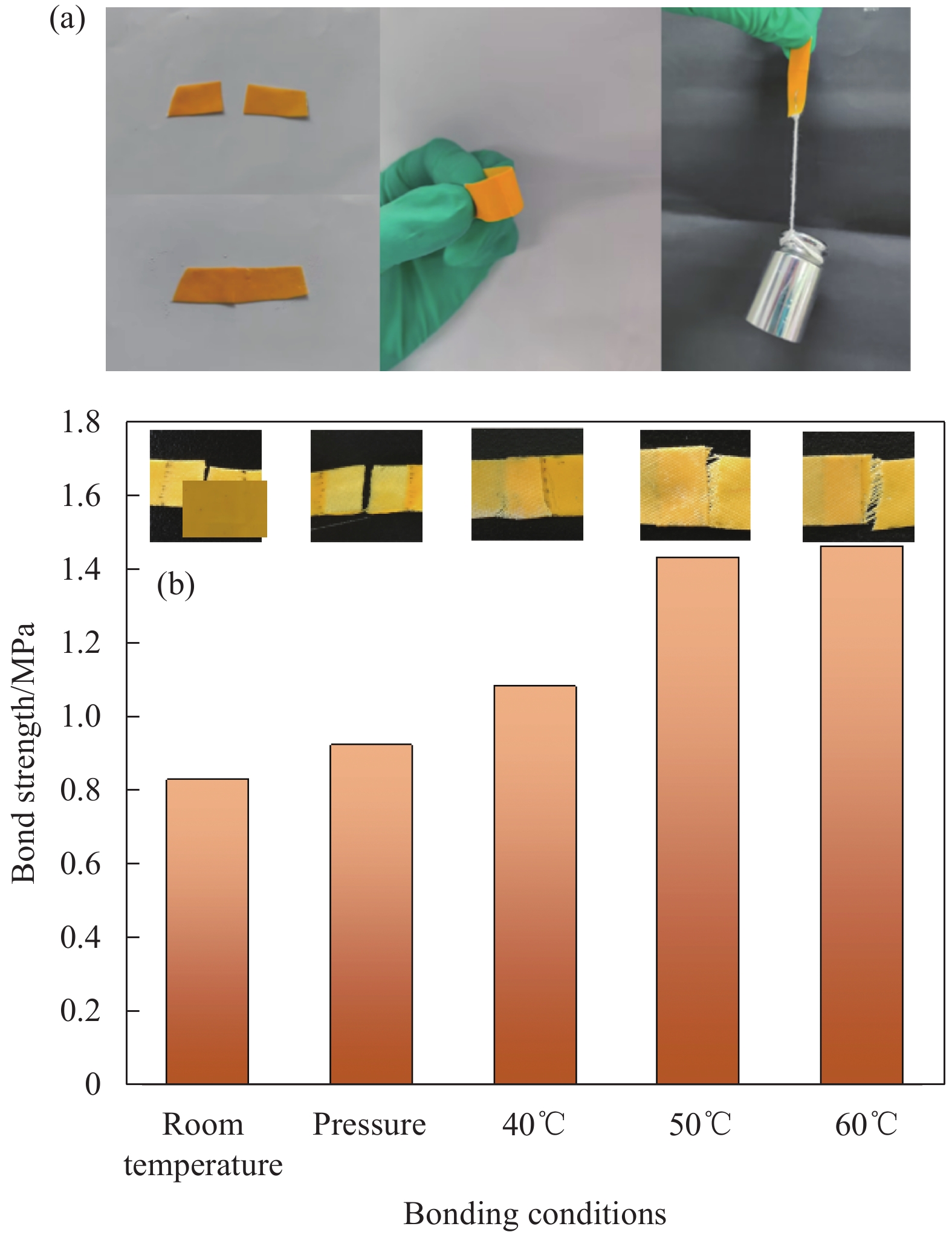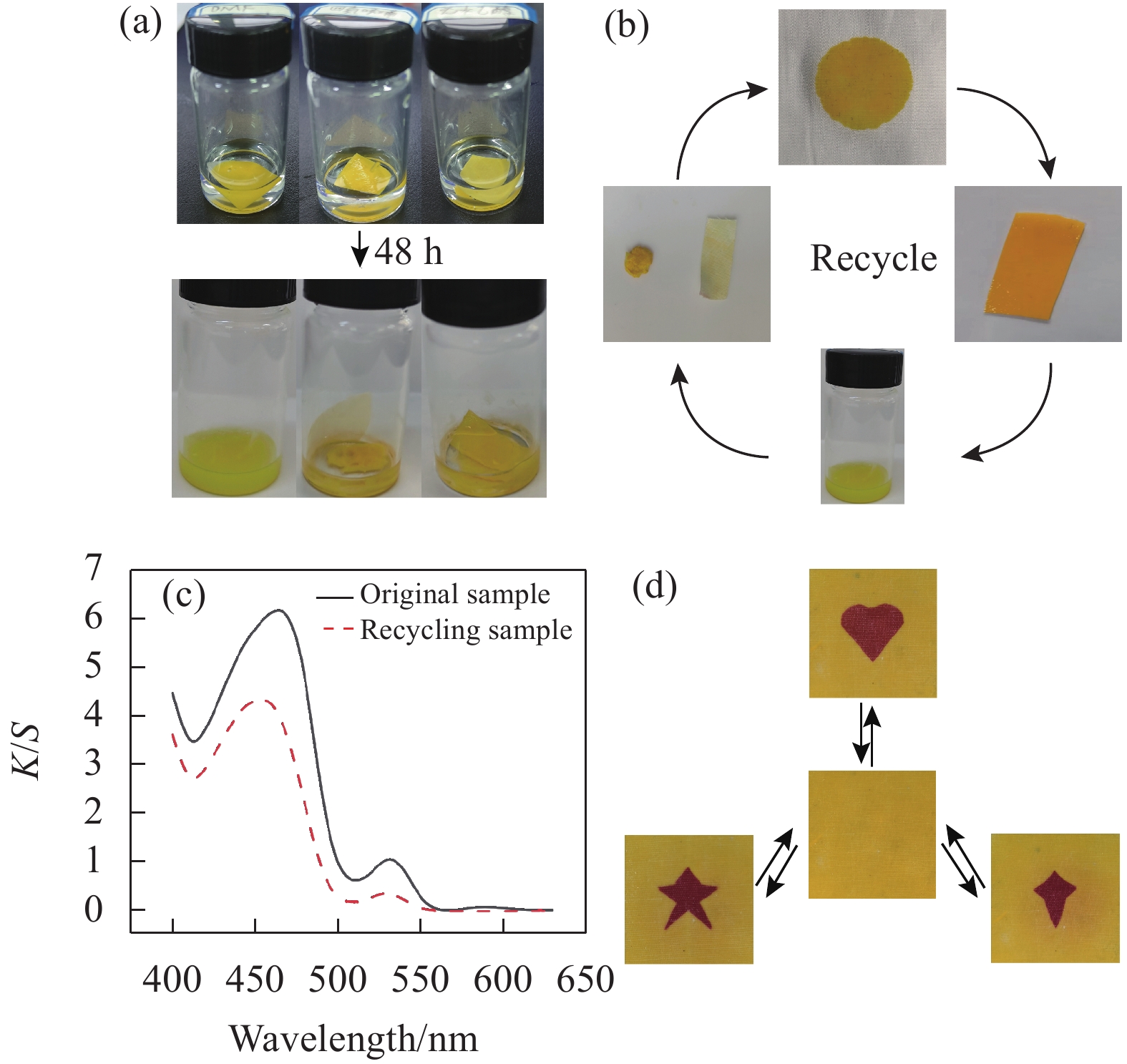Preparation and properties of self-healing photochromic polyurethane composite fabric
-
摘要: 为提高光致变色涂层织物耐用性能,采用光致变色微胶囊(PM)与两性离子聚氨酯(ZPU)制备PM/ZPU薄膜,并热压到棉织物上得到自修复光致变色PM/ZPU复合织物。对PM/ZPU复合织物的结构和形貌进行表征,并详细探讨了PM/ZPU复合织物的光致变色性能、自修复及回收利用能力。结果表明:经紫外光照射后,PM/ZPU复合织物的最大吸收波长由470 nm转移到530 nm,颜色由黄橙色变为红褐色,且具有良好的耐疲劳性能;基于两性离子的动态可逆性,PM/ZPU复合织物划痕可以在80℃下完全修复,断裂的复合织物在60℃下的粘合强度达到1.47 MPa,展现了优异的自修复性能;通过简单的溶解法可将废弃织物上的涂层进行回收并再利用,重新制备PM/ZPU复合织物依然具有良好的光致变色性能。Abstract: In order to improve the durability of photochromic coated fabrics, the photochromic microcapsules (PM) and zwitterionic polyurethane (ZPU) were used to prepare PM/ZPU films, which were then hot-pressed onto cotton fabrics to obtain the self-healing PM/ZPU composite fabrics. The structure and morphology of PM/ZPU composite fabric were characterized, and the photochromic properties, self-healing and recycling ability of PM/ZPU composite fabric were discussed in detail. The results show that the maximum absorption wavelength of PM/ZPU composite fabric changes from 470 nm to 530 nm, the color changes from yellow-orange to reddish-brown, and the fabric has good fatigue resistance. Based on the dynamic reversibility of zwitterionic, the scratches of PM/ZPU composite fabric can be completely repaired at 80℃, and the bond strength of the fractured composite fabric reaches 1.47 MPa at 60℃, showing excellent self-healing properties. The coating on the waste fabric can be recycled and reused by a simple dissolution method, and the PM/ZPU composite fabric can still be prepared with good photochromic properties.
-
Keywords:
- polyurethane /
- photochromism /
- self-healing property /
- recycling /
- composite fabric
-
-
-
[1] 曾婵娟, 籍晓倩, 刘雯雯, 等. 10, 12-二十五碳二炔酸改性聚氨酯/聚环氧乙烯纤维膜制备及其紫外光/热致变色性能[J]. 纺织学报, 2018, 39(8): 9-14. ZENG Chanjuan, JI Xiaoqian, LIU Wenwen, et al. Preparation of 10, 12-25 carbodiacetylenic acid modified polyurethane/polyepoxy-ethylene fiber film and its UV/thermochromic properties[J]. Journal of Textile Research, 2018, 39(8): 9-14(in Chinese).
[2] HUANG N, YAN X X, ZHAO W T. Influence of photochromic microcapsules on properties of waterborne coating on wood and metal substrates[J]. Coatings, 2022, 12(11): 1750. DOI: 10.3390/coatings12111750
[3] WANG X Y, MA X H, CUI S Q, et al. Preparation of a photochromic diarylethene microcapsule with high fatigue resistant and printed on cotton fabric[J]. Materials Letters, 2023, 346: 134530. DOI: 10.1016/j.matlet.2023.134530
[4] 陈鑫, 费良, 殷允杰, 等. 溶剂挥发法制备聚苯乙烯壁材光致变色微胶囊[J]. 精细化工, 2023, 40(1): 63-68. CHEN Xin, FEI Liang, YIN Yunjie, et al. Photochromic microcapsules of polystyrene wall materials were prepared by solvent volatilization[J]. Fine Chemicals, 2023, 40(1): 63-68(in Chinese).
[5] HUO Y N, ZHOU J X, XU Z S, et al. Preparation and properties of water-based photochromic polyurethane coatings containing Er(III)-doped WO3[J]. Surface and Interface Analysis, 2023, 55(4): 288-295. DOI: 10.1002/sia.7189
[6] GAO Y, ZHANG W H, HAN N, et al. Cotton fabric containing photochromic microcapsules combined thermal energy storage features[J]. Colloids and Surfaces A: Physicochemical and Engineering Aspects, 2022, 648: 129249. DOI: 10.1016/j.colsurfa.2022.129249
[7] 鲍利红, 孙佳逊. 水性光致变色聚氨酯的制备及其性能研究[J]. 涂料工业, 2015, 45(12): 7-13. DOI: 10.3969/j.issn.0253-4312.2015.12.002 BAO Lihong, SUN Jiaxun. Preparation and properties of waterborne photochromic polyurethane[J]. Coatings Industry, 2015, 45(12): 7-13(in Chinese). DOI: 10.3969/j.issn.0253-4312.2015.12.002
[8] 郭静, 胡钒, 张红娟, 等. 光致变色纺织品的制备方法及其应用[J]. 上海纺织科技, 2022, 50(12): 8-12, 43. GUO Jing, HU Fan, ZHANG Hongjuan, et al. Preparation method and application of photochromic textiles[J]. Shanghai Textile Science, 2022, 50(12): 8-12, 43(in Chinese).
[9] BAO B, FAN J, WANG W, et al. Photochromic cotton fabric prepared by spiropyran-ternimated water polyurethane coating[J]. Fibers and Polymers, 2020, 21(4): 733-742. DOI: 10.1007/s12221-020-9749-3
[10] 丁子寒, 邱华. 纳米二氧化硅改性水性聚氨酯防水透湿涂层织物的制备及其性能[J]. 纺织学报, 2021, 42(3): 130-135. DING Zihan, QU Hua. Preparation and properties of waterborne polyurethane waterproof permeable coating fabric modified by nano silica[J]. Journal of Textile Research, 2021, 42(3): 130-135(in Chinese).
[11] 张聪聪, 郑梦凯, 李伯耿. 软段结构对聚氨酯弹性体性能的影响[J]. 化工学报, 2019, 70(10): 4043-4051. ZHANG Congcong, ZHENG Mengkai, LI Bogeng. Influence of soft segment structure on properties of polyurethane elastomers[J]. CIESC Journal, 2019, 70(10): 4043-4051(in Chinese).
[12] LIU Y Y, TIAN F Y, HU J, et al. Photochromic polyurethane coatings with cross-linked structure and self-healing behavior based on the FRET Effect[J]. Macromolecular Rapid Communications, 2023, 44(13): 2300097.
[13] 闫欣悦, 丁楠洋, 王成忠. 基于D-A反应的热可逆聚氨酯合成及其碳纤维复合材料的制备与性能[J]. 复合材料学报, 2023, 41(4): 1914-1922. YAN Xinyue, DING Nanyang, WANG Chengzhong. Preparation and properties of thermoreversible polyurethane synthesis and carbon fiber composites based on D-A reaction[J]. Acta Materiae Compositae Sinica, 2023, 41(4): 1914-1922(in Chinese).
[14] 刘明光, 刘吟松, 晏欣, 等. 磺酸甜菜碱内盐聚氨酯的制备与性能[J]. 聚氨酯工业, 2015, 30(5): 18-21. LIU Mingguang, LIU Yinsong, YAN Xin, et al. Preparation and properties of polyurethanes containing betaine sulfonic acid[J]. Polyurethane Industry, 2015, 30(5): 18-21(in Chinese).
[15] 孙振龙, 张桢焱, 周容涛, 等. 两性离子聚合物材料杀菌/抗黏附功能自适应转化的设计策略[J]. 材料导报, 2020, 34(23): 23199-23204. SUN Zhenlong, ZHANG Zhenyan, ZHOU Rongtao, et al. Design strategy for adaptive transformation of bactericidal/anti-adhesion function of zwitterionic polymer materials[J]. Materials Reports, 2020, 34(23): 23199-23204(in Chinese).
[16] MAO H Y, ZHANG Q, LIN L, et al. A self-healable and recyclable zwitterionic polyurethane based on dynamic ionic interactions[J]. Polymers, 2023, 15(5): 1270. DOI: 10.3390/polym15051270
[17] ZHANG Z W, PENG P P, WU Q Y, et al. Preparation and antibacterial properties of poly(hexamethylene guanidine hydrochloride) modified ionic waterborne polyurethane[J]. Progress in Organic Coatings, 2021, 156: 106246. DOI: 10.1016/j.porgcoat.2021.106246
[18] 朱航, 刘静, 雷西萍, 等. 十四酸改性SiO2/超支化PDMS自修复涂层的制备及其超疏水性能[J]. 复合材料学报, 2023, 41(1): 227-239. ZHU Hang, LIU Jing, LEI Xiping, et al. Preparation and superhydrophobic properties of tetradecanoic acid modified SiO2/hyperbranched PDMS self-healing coatings[J]. Acta Materiae Compositae Sinica, 2023, 41(1): 227-239(in Chinese).
[19] 王学川, 张哲, 郭子东, 等. 两性离子型水性聚氨酯构效关系研究[J]. 功能材料, 2016, 47(4): 4040-4044, 4049. WANG Xuechuan, ZHANG Zhe, GUO Zidong, et al. Study on structure-activity relationship of zwitterionic aqueous polyurethane[J]. Journal of Functional Materials, 2016, 47(4): 4040-4044, 4049(in Chinese).
[20] HUANG Z X, SINA N, CHENG K, et al. Scalable inter-diffused zwitterionic polyurethanes for durable antibacterial coatings[J]. Chemical Engineering Journal, 2021, 422: 130085. DOI: 10.1016/j.cej.2021.130085
[21] 陈心怡, 李瑀, 封伟. 基于两性离子的自修复准固态聚合物电解质[J]. 高分子学报, 2022, 53(11): 1349-1357. CHEN Xinyi, LI Yu, FNEG Wei. Self-healing quasi-solid polymer electrolyte based on zwitterion[J]. Acta Polymerica Sinica, 2022, 53(11): 1349-1357(in Chinese).
[22] WANG M M, SHI X, LIU W Q, et al. A zwitterionic polyurethane-based self-healing triboelectric nanogenerator for efficient self-powered sensing[J]. Materials Letters, 2023, 333: 133629. DOI: 10.1016/j.matlet.2022.133629
[23] XIAO X, CHEN H, CHEN S J. New zwitterionic polyurethanes containing pendant carboxyl-pyridinium with shape memory, shape reconfiguration, and self-healing properties[J]. Polymer, 2019, 180: 121727. DOI: 10.1016/j.polymer.2019.121727
[24] 王有朋. 具有多重响应形状记忆和自修复两性离子聚合物的制备研究[J]. 高分子通报, 2020(6): 43-49. WANG Youpeng. Preparation of self-healing zwitterionic polymers with multiple response shape memory[J]. Polymer Bulletin, 2020(6): 43-49(in Chinese).
[25] CHEN K, ZHU H X, ZHANG Z Y, et al. Self-healing polyurethane coatings based on dynamic chemical bond synergy under conditions of photothermal response[J]. Chemical Engineering Journal, 2023, 474: 145811. DOI: 10.1016/j.cej.2023.145811
[26] 国家技术监督局. 纺织品织物透气性的测定: GB/T 5453—1997[S]. 北京: 中国标准出版社, 1997. The State Bureau of Quality and Technical Supervision. Textiles—Determination of the permeability of fabrics to air: GB/T 5453—1997[S]. Beijing: Standards Press of China, 1997(in Chinese).
[27] 胡勇杰. 纳米二氧化硅/聚醚共聚乙酰胺防水透气涂层织物的研制及其性能[J]. 纺织学报, 2018, 39(10): 104-109. HU Yongjie. Preparation and properties of nano silica/polyether copolymer acetamide waterproof breathable coating fabric[J]. Journal of Textile Research, 2018, 39(10): 104-109(in Chinese).
-
期刊类型引用(1)
1. 徐文媛,黄鸿坤,沈蒙莎,程永兵,陈曦,杨绍明. NaAlCl_4/ZSM-5@γ-Al_2O_3核壳复盐催化剂的制备及其歧化性能. 复合材料学报. 2022(10): 4602-4609 .  本站查看
本站查看
其他类型引用(0)
-
目的
光致变色纺织品在使用过程中会受到磨损、划伤等物理损伤,导致其美观性、耐用性大大降低。损坏的光致变色织物若直接废弃,将造成资源浪费和环境污染。为提高光致变色涂层织物耐用性能,本文采用光致变色微胶囊(PM)与两性离子聚氨酯(ZPU)制备PM/ZPU薄膜,并热压到棉织物上得到自修复光致变色PM/ZPU复合织物。
方法利用傅里叶红外光谱分析(FTIR)、扫描电子显微镜(SEM)对PM/ZPU复合织物的结构和形貌进行表征。通过测色配色仪测试复合织物颜色深度。将复合织物分别在紫外光照射和黑暗条件下放置一段时间,通过测色配色仪测试其颜色变化,评价其可逆光致变色性。通过光学显微镜及拉伸实验分析PM/ZPU复合织物表面划横及断裂织物的修复性能。将PM/ZPU复合织物浸渍在N,N-二甲基甲酰胺(DMF)中,待薄膜完全溶解后,重新制膜并热压到织物上,测试新织物颜色及光致变色性能,评价其回收利用能力。
结果①通过FTIR、SEM对PM/ZPU复合织物的结构和形貌表征说明成功制备了PM/ZPU复合织物。②ZPU复合织物的接触角为83.73°,PM/ZPU复合织物的接触角为76.83°,PM的加入使复合织物润湿性稍有提高。③PM/ZPU与棉织物复合后,织物在室温下5 h的透气速率为0.002 g/(cm·h),透气性下降;在90 ℃下透气速率提高到0.07 g/(cm·h),且复合织物的透气速率随时间增加逐渐降低。④经紫外光照射后,由于PM中螺噁嗪的C-O键断裂形成开环的部花菁结构,分子共轭程度增加,PM/ZPU复合织物的最大吸收波长由470 nm转移到530 nm,颜色由黄橙色变为红褐色;该开环体在可见光或避光条件下,又重新闭环形成螺噁嗪结构,颜色由红褐色恢复为黄橙色,形成光致可逆变色;且经过多次的循环照射,变色性能基本稳定。⑤ZPU复合织物和PM/ZPU复合织物表面被划伤出现划痕时,在80 ℃下修复1 min后,复合织物表面上的划痕几乎完全消失,表面恢复平整,表明在该温度下划痕完全修复,是因为复合织物经受热处理时,聚氨酯链流动性增强,迅速移动到划伤部位;聚氨酯链中季铵阳离子和磺酸阴离子之间通过静电相互作用在新的位点重新结合成离子键,从而修复损伤。⑥PM/ZPU复合织物断裂后重叠黏合,在60 ℃条件下黏合强度达到1.47 MPa,且重叠界面难以被拉开。⑦回收测试中,复合织物表面的PM/ZPU薄膜在DMF中基本完全溶解,用回收溶液重新制备的复合织物和原复合织物的颜色曲线、可逆光致变色性能基本相同。
结论利用两性离子聚氨酯(ZPU)与光变微胶囊(PM),通过热压法成功制备PM/ZPU复合织物,涂层紧密包裹着光变微胶囊起到了保护作用,有利于提高PM/ZPU复合织物的耐疲劳性。PM/ZPU复合织物在紫外光照射下20 s颜色由橙黄色变为红褐色,且经过多次循环照射,变色性能基本稳定,具有优异的可逆性和耐疲劳度。PM/ZPU复合织物表面的划痕在80 ℃下能够完全修复;且断裂的复合织物在60 ℃下的黏合强度高达1.47 MPa,显示出出色的自动缝合能力。PM/ZPU能够用DMF溶剂进行回收,并重新制得PM/ZPU复合织物,展现了优异的回收再利用能力。




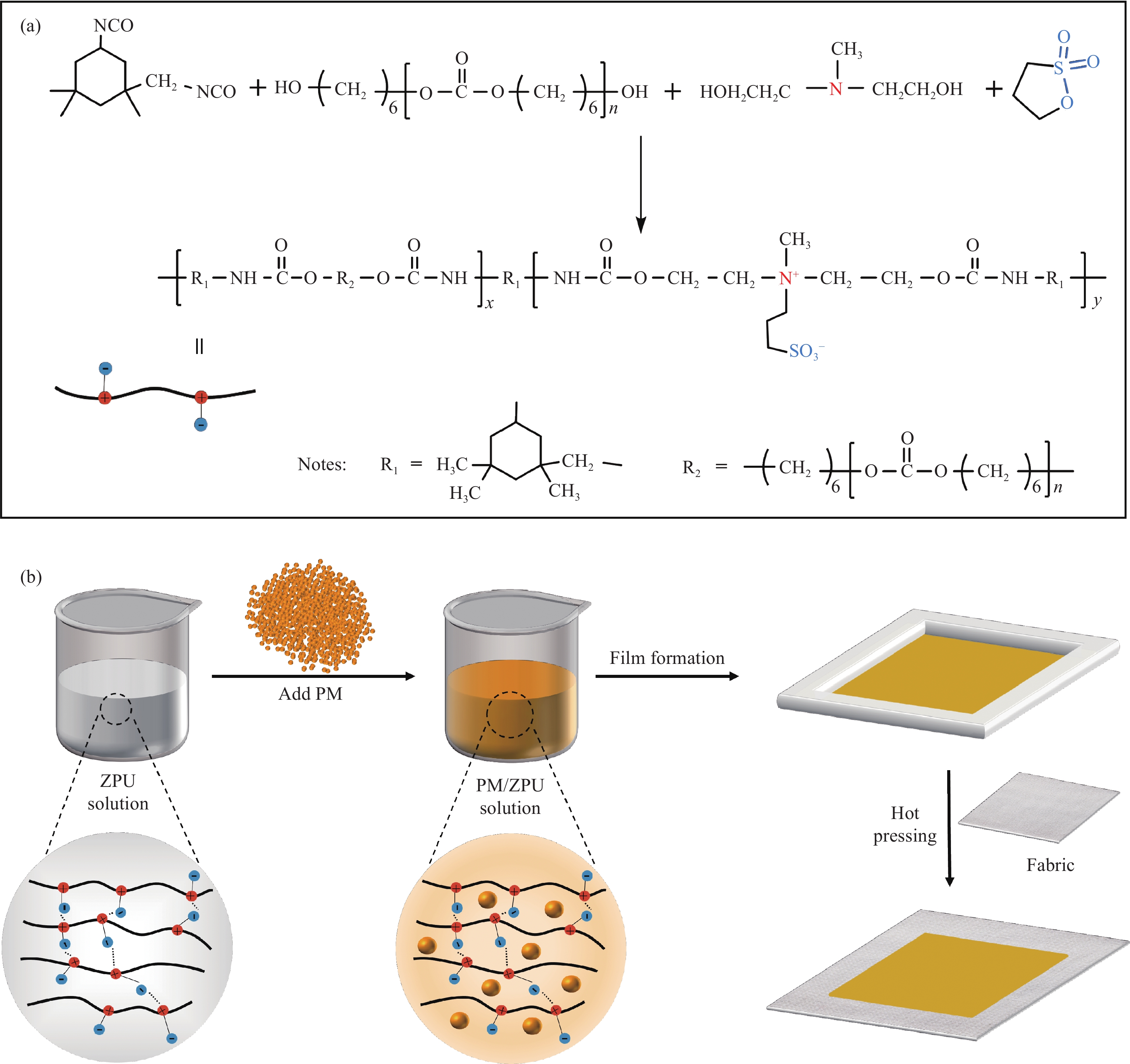
 下载:
下载:
